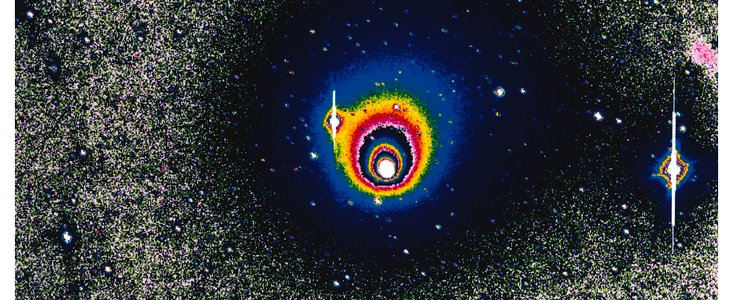Press Release
First NTT Image of Comet Hale-Bopp after Solar Conjunction
9 February 1996
This false-colour image of Comet Hale-Bopp is the first to be obtained with a major astronomical telescope after the recent conjunction with the Sun. At the time of this observation, the comet was located in the southern constellation of Sagittarius, and only 32 degrees from the Sun.
This rather difficult observation was performed with the ESO 3.5-metre New Technology Telescope (NTT) in the morning of 9 February 1996 by Griet van de Steene (astronomer), Hernan Nunez (telescope operator) and Gabriel Martin (instrument operator) of the NTT team at La Silla. The data were immediately transferred by satellite link to the ESO Headquarters in Garching where the subsequent image processing was done by Hans Ulrich Kaeufl.
Since the comet was so close to the Sun, it had to be observed in the comparatively bright morning sky. It was acquired only 10 degrees above the eastern horizon, at an airmass of no less than 5.1. Three exposures of 5 minutes each were made through a red filtre and with a 2000 x 2000 CCD in the EMMI multi-mode instrument. The image shown here is based on one flat-fielded 5-min exposure. The frame covers 9 x 9 arcmin; 1 pixel = 0.27 arcsecond; North is up and East to the left.
The present image was obtained when the comet was approximately 924 million kilometres from the Earth and 802 million kilometres from the Sun. It continues to move inwards through the solar system and will cross the orbit of Jupiter in about two weeks time, on 25 February.
A provisional evaluation of the new images indicates that Comet Hale-Bopp is apparently still developing nominally. The coma measures at least 6 arcmin across. A certain rotation of the coma isophotes is noted, clockwise from about NNE (innermost) to about NW (outermost). No other obvious asymmetries are present. The nucleus appears single of these exposures.
Some of the brighter stars show spikes in the N-S direction; this is a typical effect on the very sensitive CCD detectors. The trail of an artificial satellite crosses the photo in the upper left quadrant.
This photo signifies the beginning of a substantial Hale-Bopp observational campaign at ESO. Co-ordinated observations will be carried out during approx. 30 nights before the end of September 1996. Many different telescopes and instruments will be used.
For earlier photos of Comet Hale-Bopp obtained with ESO telescopes, please consult the ESO Hale-Bopp Homepage.
About the Release
| Release No.: | eso9609 |
| Legacy ID: | Photo 10/96 |
| Name: | Comet Hale-Bopp |
| Type: | Solar System Solar System : Interplanetary Body : Comet |
| Facility: | New Technology Telescope |
| Instruments: | EMMI |

